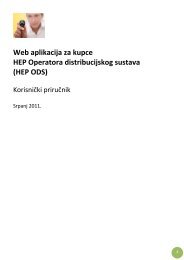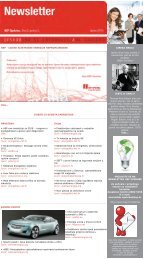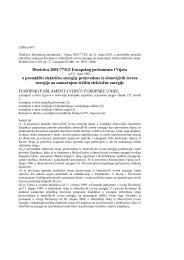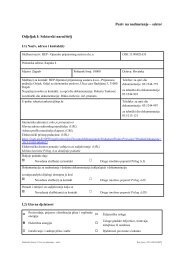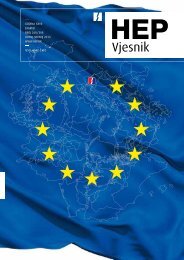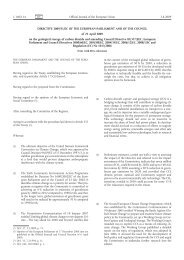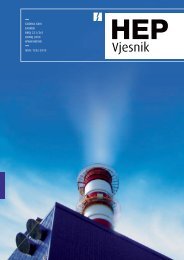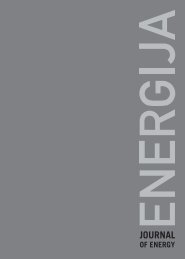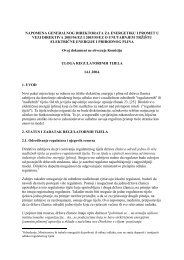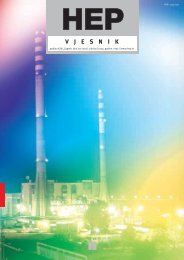Create successful ePaper yourself
Turn your PDF publications into a flip-book with our unique Google optimized e-Paper software.
pojedinaËno. Ujedno se naznaËuju posebna pitanja<br />
koja se odnose na neke zemlje jugoistoËne Europe,<br />
kandidatkinje za Ëlanstvo u Europskoj uniji.<br />
energy in each country. The particular issues which<br />
apply to some accession states in south-eastern<br />
Europe are also touched upon.<br />
2 POSTOJE∆A<br />
ELEKTROPRIVREDA U EUROPI<br />
Elektroprivreda kakva postoji u 25 dræava Ëlanica<br />
Europske unije tijekom niza godina izuzetno je<br />
dobro dokumentirana glede vlasniËke strukture<br />
kao i primarne opskrbe energijom. Razvoj ove<br />
djelatnosti u svakoj od tih zemalja dosad je<br />
uglavnom bilo iskljuËivo pitanje pojedine zemlje,<br />
unatoË, u nekim sluËajevima, dugogodiπnjega<br />
Ëlanstva u Europskoj uniji.<br />
Ipak, postoji znatna visokonaponska povezanost<br />
susjednih dræava diljem kontinenta. Meappleutim,<br />
nisu se u znaËajnom opsegu poveÊavali broj i<br />
prijenosna moÊ tih spojnih vodova, πto pak nije<br />
pridonijelo razvoju træiπta, kako se oËekivalo kada<br />
je prije 11 godina bila objavljena prva direktiva<br />
Europske unije o elektriËnoj energiji [2].<br />
Slike 1 i 2 prikazuju bruto proizvodnju elektriËne<br />
energije za svaku dræavu Ëlanicu Europske unije<br />
te proizvodnju po vrsti primarnog energenta [3].<br />
OËita je visoka raznovrsnost po vrsti i kapacitetu<br />
proizvodnje u podruËju Europske unije. PolitiËka<br />
tumaËenja mnogih direktiva Europske unije o<br />
energiji i glediπta dræava Ëlanica u odnosu na<br />
tri sastavnice energetske politike navedene u<br />
poglavlju 1 znatno se razlikuju. RazliËitost karaktera<br />
prikazane elektroopskrbe ilustrira teπkoÊe<br />
uvoappleenja bilo kakve jedinstvenosti buduÊeg<br />
træiπta elektriËne energije. ©toviπe, EU je nedavno<br />
odluËila [4] postaviti obvezujuÊi cilj postizanja 20-<br />
postotnog udjela obnovljive energije u sveukupnoj<br />
potroπnji energije u Europskoj uniji do 2020.<br />
godine. Ta postavka ima presudan utjecaj na<br />
opskrbu elektriËnom energijom, buduÊi da 80 %<br />
obnovljive energije u Europskoj uniji otpada na<br />
proizvodnju elektriËne energije. Utvrappleene koliËine<br />
buduÊe proizvodnje iz obnovljivih izvora, bez<br />
orijentacije glede drugih znaËajnih izvora primarne<br />
energije, po sebi predstavlja veliku deformaciju<br />
træiπta.<br />
2 EXISTING ELECTRICITY<br />
SUPPLY INDUSTRY IN EUROPE<br />
In terms of both ownership and primary energy<br />
supply, the electricity supply industry (ESI) existing<br />
in the 25 Member States of the EU has been<br />
extremely well-documented over many years. The<br />
development of each country’s ESI has hitherto been<br />
largely a question for that country alone despite, in<br />
some cases, many years of EU membership.<br />
High-voltage interconnection between contiguous<br />
nations does exist and is widespread throughout<br />
the continent. The increase in number and capacity<br />
of these interconnections, however, has not been<br />
widespread, which in turn has not helped the market<br />
to develop as had been hoped for when the first<br />
EU Directive on electricity supply was issued 11<br />
years ago [2].<br />
Figures 1 and 2 indicate the gross electricity<br />
production for each EU country and production by<br />
type of primary fuel [3]. The high level of diversity<br />
of type and capacity of generation across the EU is<br />
apparent. The political interpretation of the many<br />
EU Directives on energy and each nation’s view of<br />
the three components of energy policy described in<br />
Section 1 vary considerably. The diversity of the<br />
nature of electricity supply illustrated indicates the<br />
difficulties of introducing any uniformity into the<br />
market for electricity in the future. Moreover, the<br />
EU has recently resolved [4] to set a binding target<br />
of a 20% share of renewable energies in overall EU<br />
energy consumption by 2020. This statement has<br />
a profound effect on the supply of electricity, since<br />
80 % of renewable energy in the EU results in the<br />
production of electricity. Determining the amount<br />
of renewable generation in the future without any<br />
guidance regarding other major sources of primary<br />
energy is in itself a major distortion of the market.<br />
271<br />
Kennedy,<br />
M. W., StaniÊ, Z., Energetska politika u Europi i..., Energija, god. 56(2007), br. 3., str. 268∑291<br />
Kennedy, M. W., StaniÊ, Z., Energy Policy in Europe and..., Energija, vol. 56(2007), No. 3, pp. 268∑291



